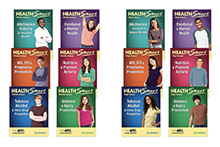Building Health Skills: Accessing Resources
By Suzanne Schrag
HealthSmart Series Editor
Where do young people get health information? Health educators hope their students understand how to find accurate answers to their questions from reliable resources. Such children and youth are in the best position to increase their knowledge in ways that will empower them to practice healthy behaviors and reduce their health risks.
We know that, while acquiring knowledge is important, an added focus on developing skills is considered a best practice for effective health education. One key health skill bridges these two elements of information and action—the skill of accessing resources, including accurate health information.
This health skill has become even more critical in today’s Internet-driven, social-media “news” climate. Young people need to know how to evaluate sources of information for accuracy and reliability, particular those found online. The National Health Education Standard for “Accessing Resources” focuses on how to identify and access valid health resources and reject unproven sources.
Accessing Information and Support, K Through 12
But how does this skill look at different grade levels? What is developmentally appropriate for children in the primary grades? young adolescents? high school students? What does it mean to access valid resources when you’re 6 versus when you’re 17?
The Standards offer guidance through the performance indicators outlined at each grade span. As students grow in knowledge, capacity and independence, what it means to practice a particular health skill also evolves, including where they look for information and support, and the means they use to evaluate the resources they find.
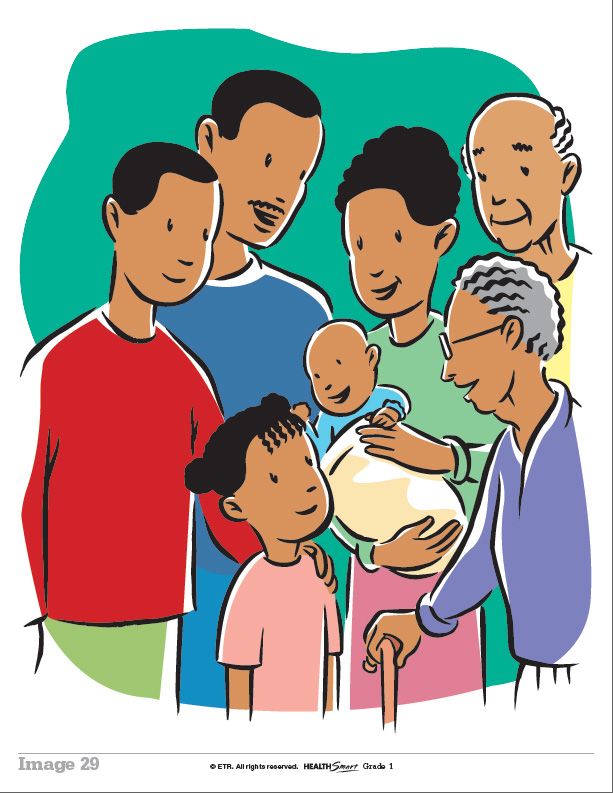 For children in Grades pre-K though 2, it is most appropriate to focus on adult help as the main resource. The two NHES performance indicators for the skill of accessing resources guide students toward locating trusted adults at home, school and in the community who can provide information and support: (1) identify trusted adults and professionals who can help promote health, and (2) identify ways to locate school and community health helpers. For these youngest students, identifying support people and being able to access adult help is key.
For children in Grades pre-K though 2, it is most appropriate to focus on adult help as the main resource. The two NHES performance indicators for the skill of accessing resources guide students toward locating trusted adults at home, school and in the community who can provide information and support: (1) identify trusted adults and professionals who can help promote health, and (2) identify ways to locate school and community health helpers. For these youngest students, identifying support people and being able to access adult help is key.
By the upper elementary grades, the focus in the Standards begins to shift toward the wider world of information and services. The NHES performance indicators for Grades 3–5 reflect that students are now connecting with and exposed to more sources of information, including the Internet. Students at these grades are expected to: (1) identify characteristics of valid health information, products and services, and (2) locate resources from home, school and community that provide valid health information.
As students move through middle school and high school, they continue to hone their information gathering skills. They need to understand and practice how to access health products and services. Middle and high school students should be able to analyze and evaluate the validity of the information, products and services they find, as well as determine when professional health services may be needed.
Of course, within the health lessons, these standards need to translate into language that makes sense to children and teens at their different grade levels and stages of development.
Some HealthSmart Examples
ETR’s HealthSmart program includes the skill of accessing resources at all grade levels, closely following the guidance of the NHES.
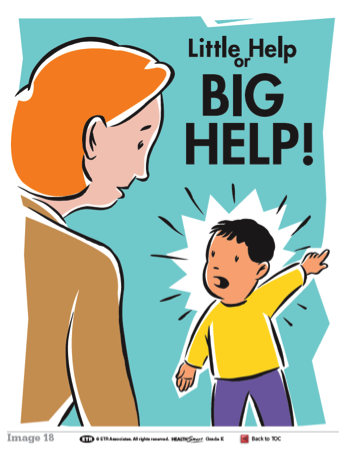 In the primary grades (K–2), there are numerous opportunities for students to identify the trusted adults at home and at school who can offer them advice and support for various health issues. For example, students identify adults who care and who can help them with troublesome feelings, illness or injury. They learn rules about only using medicines with the help of a trusted adult. They access family members and other adults who can support them to make healthy food choices and stay tobacco free. They identify adults who help them feel safe and to whom they can go for help with bullying or inappropriate touch, and practice calling 9-1-1 for help in an emergency.
In the primary grades (K–2), there are numerous opportunities for students to identify the trusted adults at home and at school who can offer them advice and support for various health issues. For example, students identify adults who care and who can help them with troublesome feelings, illness or injury. They learn rules about only using medicines with the help of a trusted adult. They access family members and other adults who can support them to make healthy food choices and stay tobacco free. They identify adults who help them feel safe and to whom they can go for help with bullying or inappropriate touch, and practice calling 9-1-1 for help in an emergency.
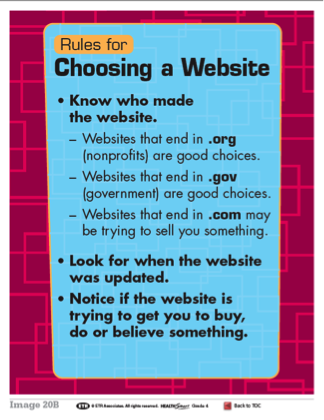 Grades 3 and 4 continue to encourage students to access caring adults by identifying emotional health role models or deciding on the best person to ask for help with a variety of different feelings. At Grades 4 and 5, students also begin to explore how to find accurate information online and are introduced to key questions they can ask to help them evaluate whether they can trust a website to give them correct information:
Grades 3 and 4 continue to encourage students to access caring adults by identifying emotional health role models or deciding on the best person to ask for help with a variety of different feelings. At Grades 4 and 5, students also begin to explore how to find accurate information online and are introduced to key questions they can ask to help them evaluate whether they can trust a website to give them correct information:
- Who made the website? Was the website created by an individual person or company (.com), a government agency (.gov), a college or other school (.edu), or a nonprofit organization (.org)?
- What’s the website’s point of view? Is it based on one person’s opinion, or is it backed up by facts? Are there data from studies or statements from experts? Are there links to and from these sources?
- When was the website created or updated? Is the date easy to find? Do the links on the website still work?
- Whom is the website for? Is the information meant for kids? teens? adults? experts? people who work in health care? everyone?
- Is the website trying to get you to buy, do or believe something?
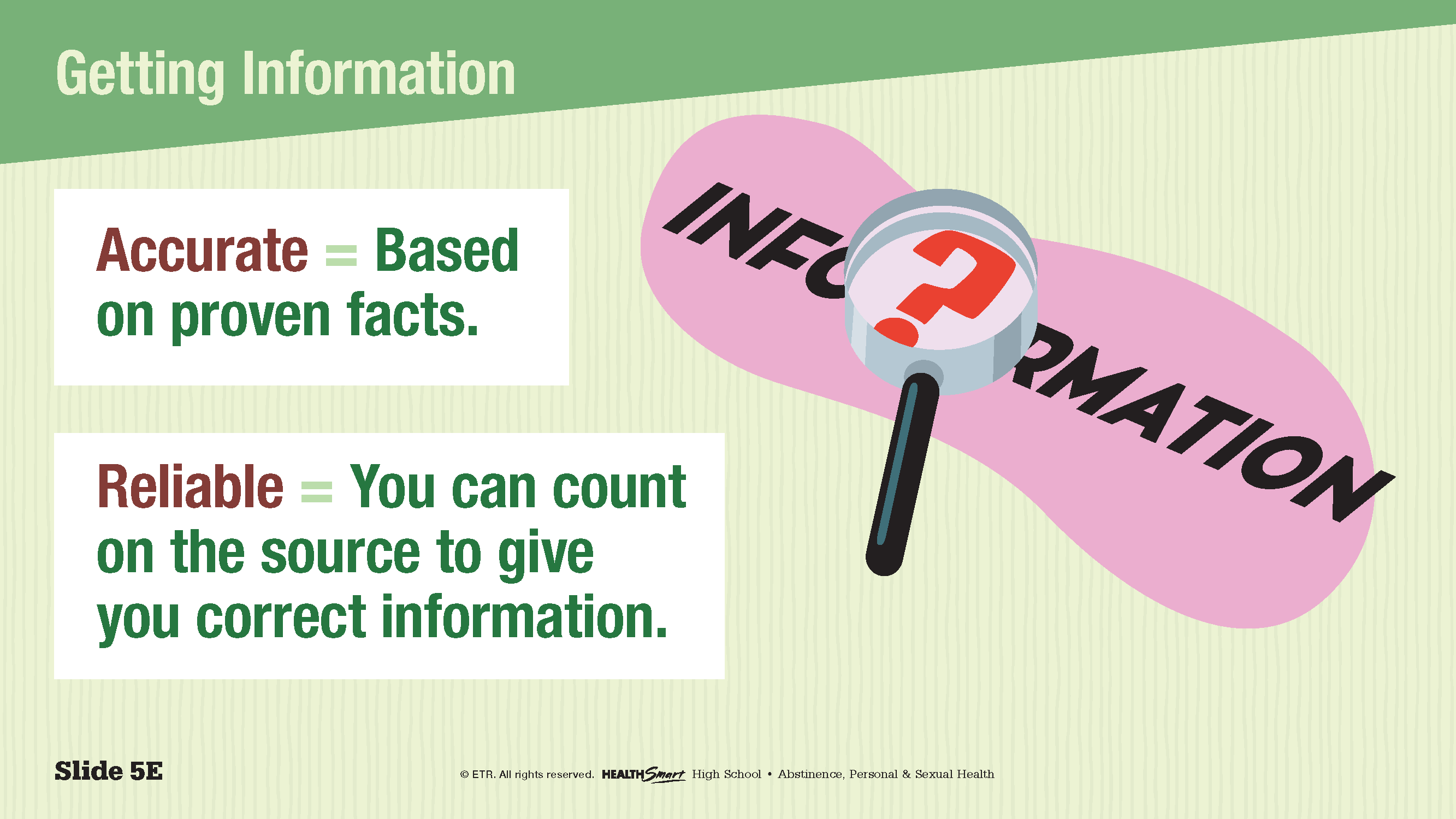 An increasingly sophisticated evaluation of resources continues throughout middle school and high school, as students identify sources of accurate information about personal and sexual health; explain the importance of seeking help for physical and mental health issues, including eating disorders, substance use and suicide thoughts; research information about tobacco, alcohol and other drugs; and identify and access community health resources.
An increasingly sophisticated evaluation of resources continues throughout middle school and high school, as students identify sources of accurate information about personal and sexual health; explain the importance of seeking help for physical and mental health issues, including eating disorders, substance use and suicide thoughts; research information about tobacco, alcohol and other drugs; and identify and access community health resources.
At each of these grade levels, students are able to practice a skills process that makes sense developmentally and helps them meet the objectives from the National Health Education Standards.
